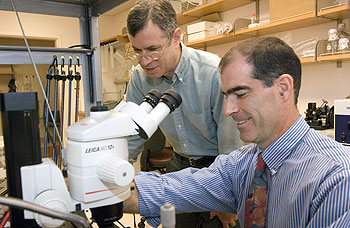Engineers at Washington University are finding common ground between the shaping of the brain and the heart during embryonic development.

Larry A. Taber, Ph.D., the Dennis and Barbara Kessler Professor of Biomedical Engineering, and Philip Bayly, Ph.D., the Hughes Professor of Mechanical Engineering, are examining mechanical and developmental processes that occur in the folding of the brain’s surface, or cortex, which gives the higher mammalian brain more surface area (and more intellectual capacity) than a brain of comparable volume with a smooth surface.
Folding is important in human brain development because some of the worst neurological problems — schizophrenia, autism and lissenchephaly (smoothness of the cortex, which leads to severe psychomotor retardation) are associated with abnormal brain folding. The neuromuscular disorder dystonia is possibly associated with faulty connectivity in the brain, which has been hypothesized to affect cortical folding.
The researchers hope that increased understanding of brain folding might someday help prevent such diseases.
Although folding is generally what makes higher mammals smart, Albert Einstein had an abnormally folded brain that resulted in genius. Certain folds in his brain were absent, which might have enabled the area associated with mathematical reasoning to be larger than normal because it didn’t have a boundary to restrict its growth.
According to Taber, the heart and the brain both begin as simple tubes that eventually develop in different ways. Looping is a key phenomenon in the early embryo where the tubular heart bends and rotates in a precise manner. Taber has found that the processes of bending and rotation in the embryonic heart are actually driven by at least two different mechanical forces. His research could help scientists better understand the roles physics and mechanics play in a normal developing heart and in the genesis of heart defects.
Bayly researches the mechanics of brain injury, recently looking into brain deformation due to acceleration of the intact skull. Both have long been aware of a theory posited by their colleague, David Van Essen, Ph.D., the Edison Professor of Neurobiology and head of the School of Medicine’s Department of Anatomy and Neurobiology.
Van Essen’s hypothesis, published in 1997 in the journal Nature, is a mechanical theory based on tension in the axons — the wiring through which nerve cells communicate. The essence of the hypothesis is that tension in axons is the driving force of folding. Van Essen’s theory is one of only about a half dozen in the literature concerning the mechanical process of folding.
In contrast, much more is known about the genetics of the brain and heart.
“We’re not sure of the similarities between heart looping and brain folding,” Taber said. “But there are only a handful of processes that cells use to create shape and form in the embryo. Developing brain and heart cells have the same basic tool set but somehow they integrate them in different ways. We’re concerned primarily with the mechanics of how these organs are constructed.”
Results so far are only preliminary. Postdoctoral researcher in biomedical engineering Gang Xu has obtained unexpected data from adult mouse brains in studies performed primarily to demonstrate the feasibility of their approach.
“We’ve observed measurable, sustained tension in the axons,” Bayly said. “This is significant because it’s what David Van Essen’s theory predicts is necessary for folding.”
MRI research on newborn ferrets is their most recent project. The ferret is the smallest mammal that has a folded brain, and unlike humans, folding occurs after the animal is born. Xu gave a presentation on the research at the Biomedical Engineering Society Annual Meeting Sept. 27-29 in Los Angeles.
The National Science Foundation is funding the research for four years at $987,000.